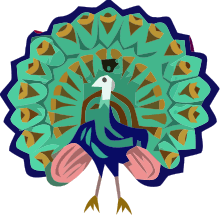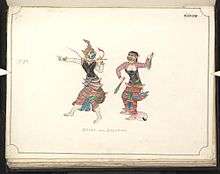Mythical creatures in Burmese folklore
A wide variety of mythical creatures are found in Burmese folklore and in mythology. Many Burmese creatures are part human or creatures capable of assuming human form. Most mythical creatures are endowed with humanistic mentalities, ability to converse with humans and also supernatural powers.[1] During the 20th century, the role and diversity of Burmese mythical creatures were diversified by Shwe Thway comics which depicted the life of the Buddha, the Jataka tales and Burmese history.
| Part of a series on the |
| Culture of Myanmar |
|---|
 |
| People |
|
Mythology and folklore |
|
Cuisine
|
|
Literature
|
|
Media |
|
Monuments
|
|
Organisations
|

The most common mythological being is the Belu, an ogre. The popularity of the Belu is due to the Yama Zatdaw, the Burmese version of the Ramayana, a very popular play in Myanmar, and also their roles in the Jatakas.

List of beings and creatures
The following is a list of beings and creatures in Burmese mythology:
Creatures mentioned in stories, plays and Burmese literature
Deities, Demons & Spirits
- Athurakal - the lowest form of deities which have pleasure half the day and suffer the other half
- Belu - usually man-eating humanoid beings capable of shapeshifting.
- Pan-kike Belu - (lit flower biters) Belu with straight fangs which eat humans. Generally malevolent.
- Panswé Belu - (lit flower danglers) Belu with curved or hooked fangs which eat flowers and fruits. Generally benevolent. An example would be Popa Medaw.
- Nat sein - a kind of spirits of humans (especially those who died violent deaths). They grant supernatural powers to those who devote but are imperceptible in the mortal world.
- Otta-saunk or Ottsar-saunk - beings cursed to roam the earth due to their strong attachment to objects or places.
- Thaik nan shin - is synonymous with Otta-saunk, glossed by Spiro as “quasi-nat,” or “the spirits who, because of their greed for treasure when they were human, have been assigned to guard the treasures of the Buddha".
- Peik-ta - beings punished with perpetual hunger or thirst.
- Sone - hags or witches
- Thayé - ghosts
- Yama Yazar - A saint, often claimed as death lord who rule the hell.
- Yetkhat - benevolent guardians of buried treasures and those hidden in tree roots.
- Zawgyi (alchemist) - a human alchemist with supernatural powers and often seen with a stick and a red hat.
Beasts
- Birds
- Galone - garuda, nemesis of the Nāgas.
- Hintha - Hamsa, swan like bird, famed as the bird with most pleasant voice; symbol of the Mon people, Mon State and Bago Region.
- Karaweik - from the Pali "karavika", a bird with a melodious cry.
- Reptiles
- Magan - Makara crocodile-like sea monster with prehensile snout.
- Nāga - serpentine dragon-like beings with great powers, enemy of the Garudas, and inhabit in sea. They are described as being able to swim through the earth as if it was water, and fly in the sky. According to the Bhuridatta Jataka the 6th of the 10 last lives of the Buddha, the Buddha was a Nāga prince.[2]
- Ngamoeyeik - a huge crocodile and character of Min Nandar and Shin Hmwe Loon the Burmese equivalent of Romeo and Juliet.
- Mammals
- Kyut - malevolent pangolin or armadillo like creatures which can assume human form and trick humans in the forests.
- Sarmaree - vain long-haired ox which values its hair.
- Thaman Chah - the weretiger, an equivalent of werewolf in European cultures.
- Spiders
- Giant Spider of Pindaya - a giant spider which held 7 princesses captive in Pindaya region.
- Hybrids
- Byala - Rakhine version of the Nawa Rupa.
- Kinnara, male and Kinnari, female - a hybrid of human and bird, often painted as humans with wings in clothing and headdresses; associated with the Shan and Kayah States.
- Manotethiha (Manussiha in Pali) - Half-human, half-lion creatures. Their appearances are somehow similar with sphinx. What differ them from sphinx is that they have two lion bodies connected to a single human head.
- Nawarupa - (lit nine bodies); a creature made from the amalgamation of parts of nine different animals.
- Nāya/ Toe-nāya/ Toe-nāga - quite similar to chimera; hybrids of seven animals including Nāga. No appearance of these creatures is found in mythology. They are artistic designs of a nāga developed by early Myanmar sculptor.
- Pyinsarupa - (lit five bodies); a creature made from the amalgamation of parts of five different animals, mascot of Myanmar Airways International.
See also
- Buddhist mythology
- Buddhist cosmology
- Buddhism in Myanmar
- Culture of Burma
References
- Mythical Creatures in Burmese Folklore, Jataka tales, History of Burma, Yama Zatdaw, Ramayana, Asura (Buddhism), Rakshasa, Garuda. (2011), 108 pag. ISBN 978-613-6-67801-6
- http://www.buddha-images.com/bhuridatta-jataka.asp
Htin Aung, Maung Folk Elements in Burmese Buddhism. London, New York: Oxford University Press, 1962.